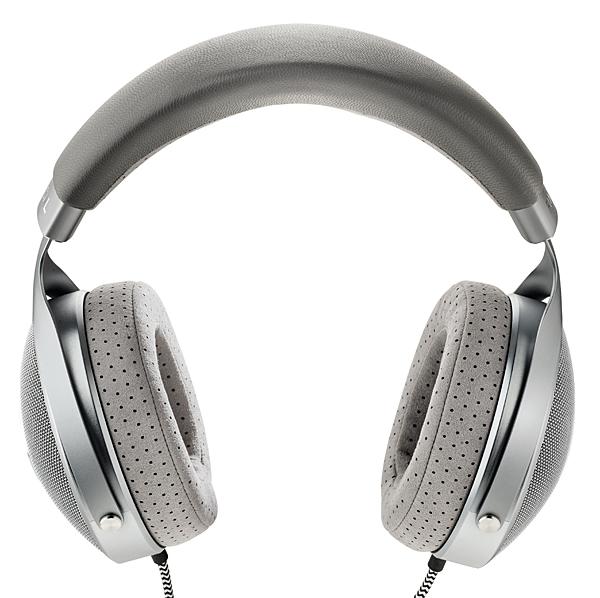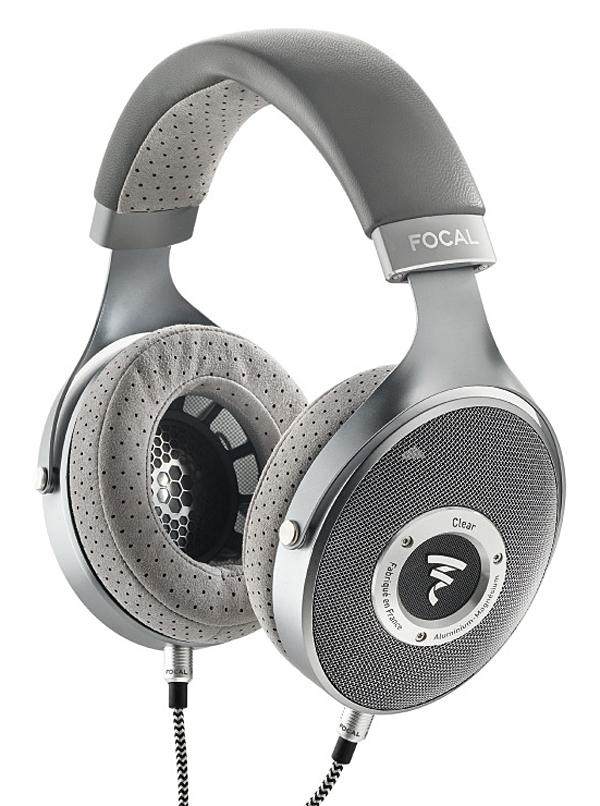Focal Clear Headphones Review

AT A GLANCE
Plus
Aluminum/magnesium diaphragms
Impeccable construction
Balanced presentation
Minus
Less than spacious imaging
THE VERDICT
Focal’s Clear headphones are admirably well-balanced performers with irreproachable build quality and a gorgeous look.
Is $1,499 a lot to pay for headphones? Well, how much is a lot? Only you can make the definitive decision about what is a good buy and what would be an undue burden on your checking account. Here’s how Focal thought through the problem. This formidable loudspeaker manufacturer gave its emergent headphone line its best shot in the Focal Utopia, a four-thousand-dollar product that we hailed with a five-star review. Its latest offering, the Focal Clear, borrows technology developed for the Utopia and cuts the price by more than half.
Bespoke Tailoring
If the black-and-silver Utopia is “like a rock star in a leather jacket,” as I wrote, the Clear is more like an aristocrat in a dove-gray Savile Row suit. It is an unusual color choice and a great look. The most visually prominent features are the silver mesh that conceals the backsides of the drivers and the pale gray perforated microfiber earpads and headband pad.
Those features are not just sweetly cosmetic but functionally crucial. These are open-backed headphones, hence the mesh, which allows unwanted soundwaves from the rear of the drivers to pass through the shell (and works in both directions, so you can also hear the doorbell ring). They are therefore designed mainly for indoor, not outdoor, use. The 1-millimeter perforations in the earpads are said to further enhance openness to the outside world.
Like the Utopia, the Clear uses what Focal refers to as an “M-shaped inverted dome” diaphragm on the driver, though the material changes from expensive and difficult to process pure beryllium to magnesium-coated aluminum. In both models, the dome is placed as far from the ear as possible, and is attached to a copper voice coil, wound without a former to minimize moving mass.
Focal has found several ingenious ways of making these headphones easy on the head. The leather-topped headband and solid aluminum yoke are designed to distribute weight evenly, with vertical earcup adjustment via an unseen mechanism inside the leather-topped headband. The softness of the earpads makes the Clears even more comfortable. I could wear them for a couple of hours before becoming aware of the weight (about a pound). There is also a Clear Professional version, with black and red cosmetics but the same specs, for a couple of hundred dollars more. (You do get a spare set of the snazzy red earpads, and a different compliment of cables, though.)
The set of cables packed with the Clear actually improves on the Utopia, which came with only a sometimes awkward 13-foot cable. The Clear includes two 10-foot cables, terminated in quarter-inch unbalanced or XLR balanced plugs, plus a 4-foot cable with unbalanced mini-plug. Like the headphones, the cables are dressed to kill, with a denim-like cloth sheath that is pleasant to look at and even to touch. A hard-shell case is also included.
Associated equipment included an AudioQuest DragonFly Red amp/DAC fed by a Windows 10 desktop PC for hi-res files and a Moon by Simaudio Neo 230HD amp/DAC fed by the analog output of an Oppo BDP-83 Special Edition universal disc player. For casual break-in listening I streamed Spotify on a Samsung Galaxy Tab 10.1.
Trickle Down
Because the Clear draws so much of its design ethos and feature set from the Utopia, comparisons are not only inevitable but necessary, despite the large gap in price. Before listening I’d have guessed that my review would be about the Clear delivering a large percentage of the Utopia’s virtues at less than half the price. Listening led me to change the emphasis. While the Clear was an excellent pair of cans, even for the price, the Utopia ended up being more compelling in a way that justified its higher price.
As I revisited test tracks I’d used for the Utopia, the Clear checked many of the same boxes. Its balance of frequencies, especially in the crucial midrange, was beyond reproach, free of gross flaws and even minor ones. Bass was tight and disciplined. The imaging of these dynamic headphones was scrupulously focused—perhaps not as gossamer and airy as a comparably priced planar model, but more dense and concentrated. What I missed in comparison with the Utopia was the nth degree of refinement, the more intense tone color, the sense of barriers falling, and the kind of transparency that’s an emotional sucker-punch. The Clear entertained and satisfied me, but the Utopia kept me in a constant state of surprise and amazement.
Still, had I never heard the Utopia, I’d have found the Clear as satisfying in its own way as any other headphones I’ve tried. It excelled at delicately balancing complex and tricky textures like the stinging guitars in Led Zeppelin’s “Dancing Days” (24-bit/96kHz FLAC) and the strings in the opening movement of Beethoven’s Fifth with Carlos Kleiber leading the Vienna Philharmonic (24/88.2 FLAC). In the 19-minute Yes epic “Close to the Edge” (Blu-ray, 24/96 LPCM stereo mix), the Clear got the bold strokes right (pipe organ not too sizzly) while delighting in the small details (Jon Anderson’s slight smoker’s rasp in the quiet passage of “I Get Up, I Get Down”).

Listening Afresh
To be fair, it’s rare for one product’s listening sessions to be so heavily overshadowed by another’s, so the Clear deserved some fresh perspectives with different material. Neil Young’s Harvest (DVD-Audio, MLP stereo) was completely fulfilling, with the Clear delivering believable acoustic guitar, crackling electric guitar, and a focused but highly natural approach to voice, including the delicious A-list backing vocals of Crosby, Stills, Nash, Ronstadt, and Taylor. It perfectly suited the album’s mellow tonal balance, and conveyed its characteristic richness without any thickening.
On the title track of Steely Dan’s Aja (SACD stereo), Wayne Shorter’s tenor sax solo floated atop Steve Gadd’s drum solo with the two in perfect balance. (Balance was a word that came up repeatedly in my notes.) The Japanese SACD is a bit soft-edged, but luscious, and the Clear let it be that way.
The Concerto for Oboe and Small Orchestra and other works for wind instruments by Richard Strauss featured soloist Alexei Ogrintchouk with Andris Nelsons conducting the Royal Concertgebouw Orchestra (Bis SACD stereo). The true, uncolored timbre of the oboe contrasted with the apparently more distant-miked orchestra, which emerged restrained but not softened. These dynamic headphones scrupulously imaged the decays, though the familiar ambience of Concertgebouw Hall was not as spacious as either the real thing or the approximation I’d expect to hear with a good set of planar headphones.
The most startling moment I spent with the Clear came during Debussy’s Complete Music for Two Pianos, with Stephen Coombs and Christopher Scott (CD). The opening bars of “En Blanc et Noir” surprised me because they seemed to be coming from speakers, or perhaps even from pianos, but not from headphones. It took me a few seconds to adjust.
Conclusion
The Focal Clear is an exquisite-looking and brilliantly executed pair of headphones. Its extremely well-balanced performance would provide long-term satisfaction for an overwhelming majority of listeners. Yes, if you’re the questing type and money is no object, you can spend more and get more—but a lot of folks with four figures to spend might want to stop right here.



























































